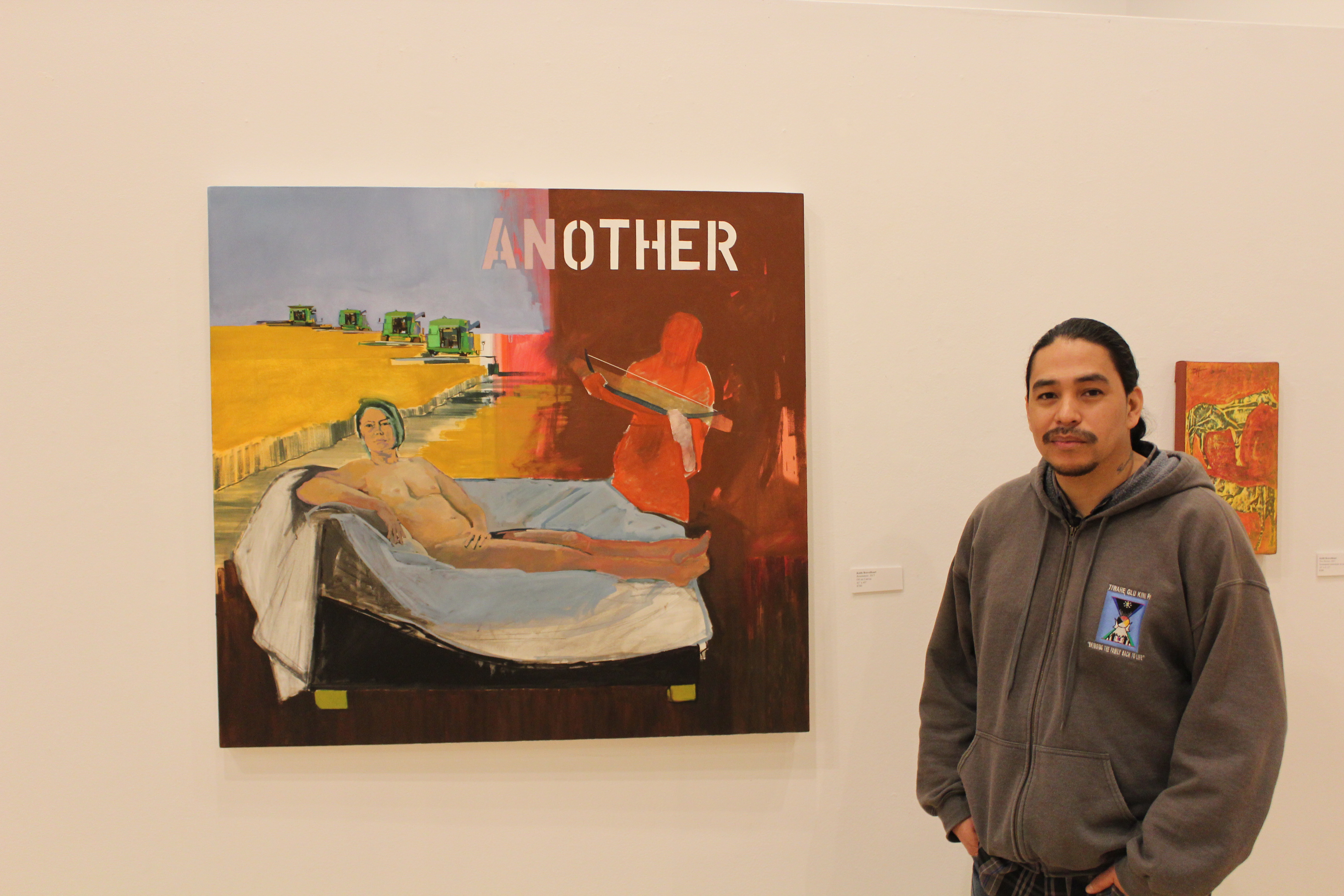
Native American art student wins awards
Third year graduate student Keith BraveHeart spends a lot of time in the art studio of the Warren M. Lee Center for Fine Arts.
BraveHeart’s painting “Retainment” won best of show at the Stilwell Art Exhibition, and is displayed there along with several more of BraveHeart’s paintings and other student work.
“The (USD) art community brings a lot of different perspectives, existences that help inspire me,” BraveHeart said.
BraveHeart was one of 28 Lakota artists from around the country to be selected as part of an exhibit at the Journey Museum & Learning Center in Rapid City in March. Hosted by the Center for American Indian Research and Native Studies (CAIRNS), the exhibition will show works about the 1890 Wounded Knee Massacre.
BraveHeart grew up in the small town of Kyle, South Dakota on the Pine Ridge Indian Reservation of the Oglala Lakota. He developed a passion for art in high school. From there, he went to the Institute of American Indian Arts in Santa Fe, New Mexico, where he received his bachelor’s degree. He is now in his third and final year working towards his master’s of fine arts in painting at USD.
Cory Knedler, chair of fine arts, said BraveHeart’s art focuses on Native American youth and how they are working their way through two different worlds.
“They’ve got the Native American traditions that they need to continue to keep alive, and we’ve also got those same students spending time in what we really consider a Western culture,” Knedler said. “Keith has been putting his observations and thoughts down on canvas about how these two different cultures are coming together in these very unique, Native American students.”
Knedler said the Master of Fine Arts program is for “very serious students.”
“(It’s for students) who want to be the best artist that they can be,” said Knedler. “It’s for students who want to be professional artists, or want to teach art at the university level.”
The seminal project of the MFA degree is a thesis exhibition, where the MFA candidate submits work they did over the course of the degree to a committee of faculty. The committee asks a series of questions in which the MFA candidate must defend their art. BraveHeart’s thesis exhibition is in April.
BraveHeart calls himself a contemporary or modern native artist. His art takes a strong influence from his Native American cultural background.
“For my tribal nation, and also I would say for many tribal nations, art and culture aren’t separate,” he said. “Art is a part of life. It’s an extension of culture. It’s a reflection of life. It’s very important to the identity and the community or the way the individuals in that community see themselves in relation to the world.”
Each piece of art BraveHeart creates takes a lot of care and time, he said. It took him a month to paint his 45 by 45 inch painting “Retainment.” The process starts by assembling the materials and building the canvas. After that, BraveHeart said he brainstorms what he wants the art to say.
It’s important not to be attached to the way something looks in the process, BraveHeart said.
“(It is important to) see what happens during that process, leaving it open for things to shift or change around, allowing time for chance to happen,” he said. “If something like paint drips happen and it looks nice, keeping that, or not being totally sold on one color or one placement of a shape, or object, having the bravery to feel like you’re not going to mess something up.”
During the summers, BraveHeart has spent his time working with young Native American artists through the Oscar Howe Summer Art Institute, and annual art program at USD. Native American students in grades 11 through 12 are given the chance to demonstrate their skills and work with professionals from the area, going on field trips to local museums and cultural facilities.
BraveHeart, who was once a student of the program, has become the assistant director of it.
“Keith has done so much more than we get to see on a daily basis,” Knedler said. “He’s also curated many exhibitions. He recruits for the Oscar Howe Art Institute. If you don’t see Keith in his studio, that doesn’t mean he’s not working. He’s probably helping other artists get their own art work out there.”

